-
 Bitcoin
Bitcoin $106,754.6083
1.33% -
 Ethereum
Ethereum $2,625.8249
3.80% -
 Tether USDt
Tether USDt $1.0001
-0.03% -
 XRP
XRP $2.1891
1.67% -
 BNB
BNB $654.5220
0.66% -
 Solana
Solana $156.9428
7.28% -
 USDC
USDC $0.9998
0.00% -
 Dogecoin
Dogecoin $0.1780
1.14% -
 TRON
TRON $0.2706
-0.16% -
 Cardano
Cardano $0.6470
2.77% -
 Hyperliquid
Hyperliquid $44.6467
10.24% -
 Sui
Sui $3.1128
3.86% -
 Bitcoin Cash
Bitcoin Cash $455.7646
3.00% -
 Chainlink
Chainlink $13.6858
4.08% -
 UNUS SED LEO
UNUS SED LEO $9.2682
0.21% -
 Avalanche
Avalanche $19.7433
3.79% -
 Stellar
Stellar $0.2616
1.64% -
 Toncoin
Toncoin $3.0222
2.19% -
 Shiba Inu
Shiba Inu $0.0...01220
1.49% -
 Hedera
Hedera $0.1580
2.75% -
 Litecoin
Litecoin $87.4964
2.29% -
 Polkadot
Polkadot $3.8958
3.05% -
 Ethena USDe
Ethena USDe $1.0000
-0.04% -
 Monero
Monero $317.2263
0.26% -
 Bitget Token
Bitget Token $4.5985
1.68% -
 Dai
Dai $0.9999
0.00% -
 Pepe
Pepe $0.0...01140
2.44% -
 Uniswap
Uniswap $7.6065
5.29% -
 Pi
Pi $0.6042
-2.00% -
 Aave
Aave $289.6343
6.02%
How to operate when WMA is blunted? What should I do if WMA fails in long-term sideways trading?
When WMA is blunted in crypto trading, adjust parameters or use RSI and MACD to gain clearer market insights and adapt strategies for sideways trends.
Jun 15, 2025 at 02:28 pm
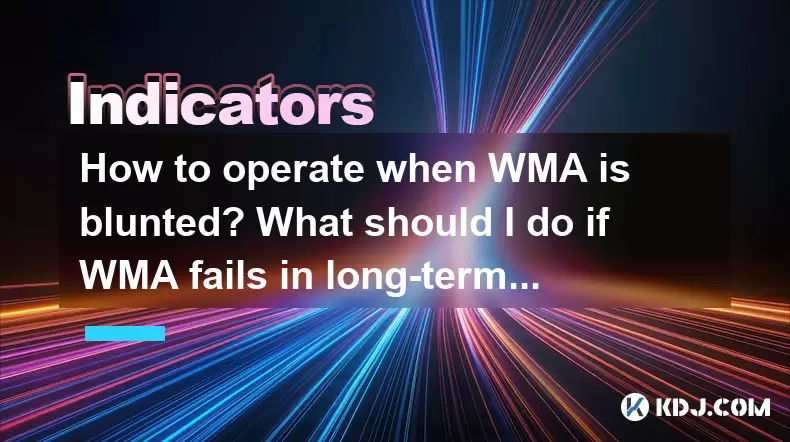
How to Operate When WMA is Blunted? What Should I Do If WMA Fail in Long-term Sideways Trading?
In the cryptocurrency market, the Weighted Moving Average (WMA) is a popular technical analysis tool used to identify trends and potential entry or exit points for trades. However, like any indicator, WMA can become blunted or fail to provide reliable signals, especially during long-term sideways trading. This article will explore how to operate effectively when WMA is blunted and what to do if it fails in long-term sideways trading.
Understanding WMA and Its Limitations
The Weighted Moving Average (WMA) assigns more weight to recent price data, making it more responsive to new information compared to a simple moving average. However, this sensitivity can also lead to blunted signals in certain market conditions. When WMA becomes blunted, it means that the indicator is not providing clear signals about the direction of the market, often resulting in false positives or negatives.
In long-term sideways trading, the WMA can fail to capture the market's direction because the price action remains within a tight range, causing the moving average to oscillate without a clear trend. This can lead traders to make poor decisions based on misleading signals.
Identifying When WMA is Blunted
To effectively operate when WMA is blunted, it's crucial to first identify when this is happening. Signs of a blunted WMA include:
- Frequent crossovers: If the WMA is crossing above and below the price too frequently, it may indicate that the indicator is not providing reliable trend information.
- Flattening of the WMA line: When the WMA line becomes flat or shows minimal slope, it suggests that the market is in a state of equilibrium, and the WMA is not capturing any significant trend.
- Divergence from price action: If the WMA is moving in a different direction from the actual price movement, it can be a sign that the indicator is not accurately reflecting the market's behavior.
Adjusting WMA Parameters
One way to address a blunted WMA is to adjust the parameters of the indicator. Here are some steps to do this:
- Increase the period: Using a longer period for the WMA can help smooth out short-term fluctuations and provide a clearer picture of the overall trend. For example, if you are using a 20-period WMA, try increasing it to 50 or 100 periods.
- Decrease the period: Conversely, if the market is particularly volatile, a shorter period might help the WMA respond more quickly to changes in price action. For instance, reducing the period from 20 to 10 might be beneficial.
- Experiment with different weighting schemes: Some trading platforms allow you to adjust the weighting scheme used in the WMA. Experimenting with different schemes can help you find one that better suits the current market conditions.
Using Complementary Indicators
When the WMA is blunted, using complementary indicators can help provide a more comprehensive view of the market. Some effective indicators to use alongside WMA include:
- Relative Strength Index (RSI): The RSI can help identify overbought or oversold conditions, which can be useful when the WMA is not providing clear signals.
- Moving Average Convergence Divergence (MACD): The MACD can help confirm trends and provide additional signals about potential trend reversals.
- Bollinger Bands: These bands can help identify periods of high or low volatility, which can be useful in understanding the context of the WMA's signals.
Strategies for Long-Term Sideways Trading
When the WMA fails in long-term sideways trading, it's important to have alternative strategies in place. Here are some approaches to consider:
- Range trading: In a sideways market, prices tend to oscillate within a specific range. Identify the upper and lower bounds of this range and consider buying near the lower bound and selling near the upper bound.
- Breakout trading: Even in a sideways market, there can be moments of volatility that lead to breakouts. Watch for signs of a breakout and be ready to enter a trade if the price moves decisively above the upper bound or below the lower bound of the range.
- Volatility trading: Use indicators like the Average True Range (ATR) to gauge market volatility. Enter trades when volatility increases, as this can signal a potential end to the sideways movement.
Practical Steps for Operating When WMA is Blunted
Here are some practical steps to take when you notice that the WMA is blunted:
- Monitor the market closely: Pay attention to price action and other market indicators to get a better sense of the market's direction.
- Use multiple timeframes: Analyzing the WMA on different timeframes can help you identify whether the blunted signal is a short-term phenomenon or a more persistent issue.
- Adjust your trading strategy: If the WMA is not providing reliable signals, consider using alternative strategies like those mentioned above.
Practical Steps for When WMA Fails in Long-Term Sideways Trading
When the WMA fails in long-term sideways trading, follow these steps:
- Identify the trading range: Use tools like horizontal lines on your chart to clearly mark the upper and lower bounds of the range.
- Set entry and exit points: Determine where you will enter and exit trades based on the range. For example, you might enter a long position near the lower bound and exit near the upper bound.
- Use stop-loss orders: To manage risk, place stop-loss orders just outside the trading range to protect against unexpected breakouts.
- Monitor for breakouts: Keep an eye on the market for any signs of a breakout from the range, and be prepared to adjust your strategy accordingly.
Frequently Asked Questions
Q: Can I use WMA for short-term trading if it's blunted in long-term analysis?
A: Yes, you can still use WMA for short-term trading even if it's blunted in long-term analysis. Short-term price movements may still be captured effectively by the WMA, especially if you adjust the period to a shorter timeframe.
Q: How can I tell if the WMA is starting to become reliable again after being blunted?
A: Look for consistent signals that align with price action. If the WMA starts to show clear trends and fewer false signals, it may be regaining reliability. Also, check if other indicators like RSI or MACD are confirming the WMA's signals.
Q: Are there any specific cryptocurrencies where WMA tends to be more reliable?
A: The reliability of WMA can vary across different cryptocurrencies, often depending on their liquidity and volatility. Generally, more liquid cryptocurrencies like Bitcoin and Ethereum may provide more reliable WMA signals due to their higher trading volumes and less erratic price movements.
Q: Should I completely abandon WMA if it fails in long-term sideways trading?
A: Not necessarily. While you might need to rely more on other strategies and indicators during such periods, WMA can still be useful once the market starts trending again. It's important to use WMA in conjunction with other tools and adapt your approach based on market conditions.
Disclaimer:info@kdj.com
The information provided is not trading advice. kdj.com does not assume any responsibility for any investments made based on the information provided in this article. Cryptocurrencies are highly volatile and it is highly recommended that you invest with caution after thorough research!
If you believe that the content used on this website infringes your copyright, please contact us immediately (info@kdj.com) and we will delete it promptly.
- 2025-W Uncirculated American Gold Eagle and Dr. Vera Rubin Quarter Mark New Products
- 2025-06-13 06:25:13
- Ruvi AI (RVU) Leverages Blockchain and Artificial Intelligence to Disrupt Marketing, Entertainment, and Finance
- 2025-06-13 07:05:12
- H100 Group AB Raises 101 Million SEK (Approximately $10.6 Million) to Bolster Bitcoin Reserves
- 2025-06-13 06:25:13
- Galaxy Digital CEO Mike Novogratz Says Bitcoin Will Replace Gold and Go to $1,000,000
- 2025-06-13 06:45:13
- Trust Wallet Token (TWT) Price Drops 5.7% as RWA Integration Plans Ignite Excitement
- 2025-06-13 06:45:13
- Ethereum (ETH) Is in the Second Phase of a Three-Stage Market Cycle
- 2025-06-13 07:25:13
Related knowledge

How to confirm the effectiveness of the average price line support in the time-sharing chart?
Jun 17,2025 at 12:56am
Understanding the Time-Sharing Chart and Its RelevanceIn cryptocurrency trading, time-sharing charts play a crucial role in analyzing short-term price movements. These charts typically display price fluctuations over a specific period, often ranging from minutes to hours. Traders rely on them to make quick decisions based on real-time data. The average ...

What does it mean when the momentum indicator breaks above the zero axis?
Jun 17,2025 at 12:43am
Understanding the Momentum IndicatorThe momentum indicator is a technical analysis tool used to measure the speed or velocity of price movements in cryptocurrency markets. It helps traders identify potential trend reversals, overbought or oversold conditions, and confirms existing trends. The indicator typically oscillates around a zero line, with value...
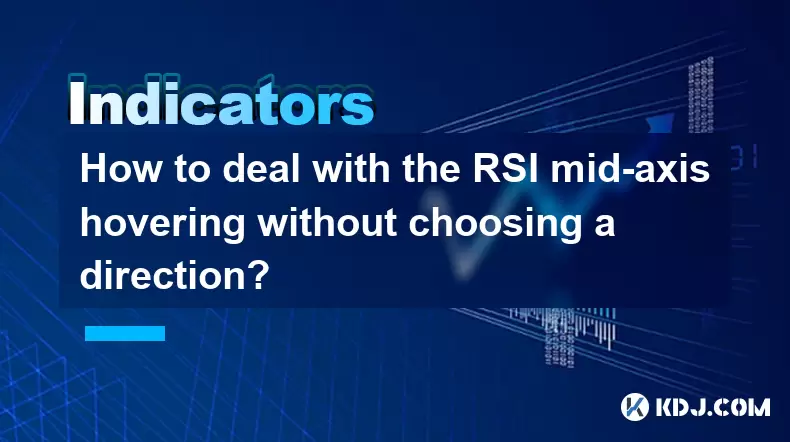
How to deal with the RSI mid-axis hovering without choosing a direction?
Jun 17,2025 at 02:02am
Understanding RSI Mid-Axis Hovering in Cryptocurrency TradingThe Relative Strength Index (RSI) is a popular momentum oscillator used by traders to assess whether an asset is overbought or oversold. In cryptocurrency markets, it's common for the RSI to hover around its mid-axis, typically at the 50 level, without showing a clear upward or downward trend....
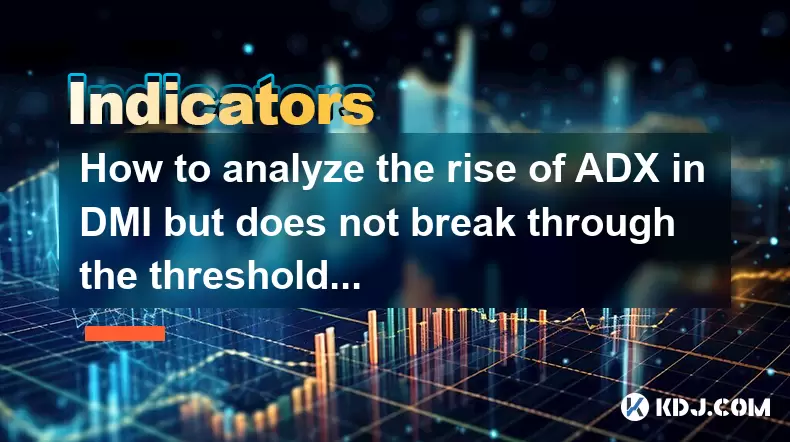
How to analyze the rise of ADX in DMI but does not break through the threshold?
Jun 16,2025 at 11:49pm
Understanding ADX and DMI in Cryptocurrency TradingIn cryptocurrency trading, ADX (Average Directional Index) is a technical indicator used to measure the strength of a trend. It works in conjunction with the DMI (Directional Movement Indicator), which includes two components: +DI (Positive Directional Indicator) and -DI (Negative Directional Indicator)...
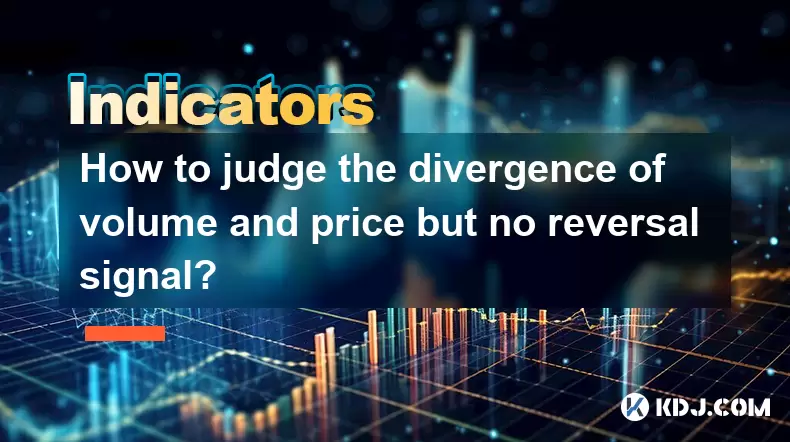
How to judge the divergence of volume and price but no reversal signal?
Jun 17,2025 at 12:28am
Understanding Volume and Price DivergenceIn the world of cryptocurrency trading, volume and price are two key indicators that traders monitor closely. Divergence occurs when these two metrics move in opposite directions. For example, if the price of a cryptocurrency is rising but its volume is declining, this could signal weakening momentum. However, it...
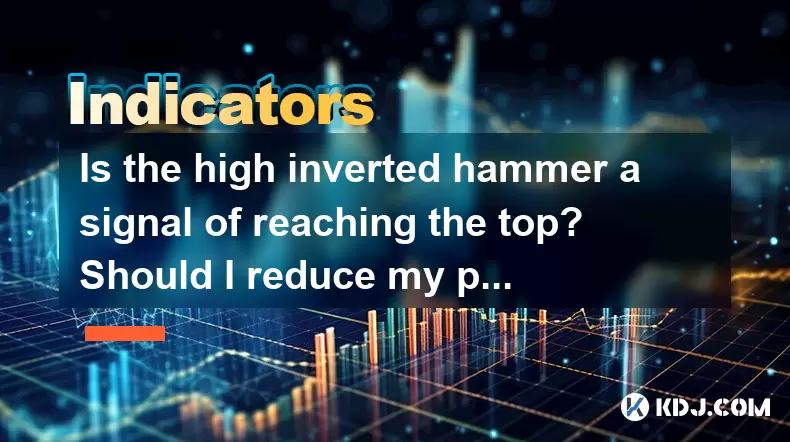
Is the high inverted hammer a signal of reaching the top? Should I reduce my position?
Jun 17,2025 at 02:28am
What Is a High Inverted Hammer Candlestick Pattern?The high inverted hammer is a candlestick pattern often observed in cryptocurrency price charts. It appears as a candle with a small body near the lower end of the trading range, accompanied by a long upper wick that is typically two to three times the length of the body. This formation suggests that bu...

How to confirm the effectiveness of the average price line support in the time-sharing chart?
Jun 17,2025 at 12:56am
Understanding the Time-Sharing Chart and Its RelevanceIn cryptocurrency trading, time-sharing charts play a crucial role in analyzing short-term price movements. These charts typically display price fluctuations over a specific period, often ranging from minutes to hours. Traders rely on them to make quick decisions based on real-time data. The average ...

What does it mean when the momentum indicator breaks above the zero axis?
Jun 17,2025 at 12:43am
Understanding the Momentum IndicatorThe momentum indicator is a technical analysis tool used to measure the speed or velocity of price movements in cryptocurrency markets. It helps traders identify potential trend reversals, overbought or oversold conditions, and confirms existing trends. The indicator typically oscillates around a zero line, with value...

How to deal with the RSI mid-axis hovering without choosing a direction?
Jun 17,2025 at 02:02am
Understanding RSI Mid-Axis Hovering in Cryptocurrency TradingThe Relative Strength Index (RSI) is a popular momentum oscillator used by traders to assess whether an asset is overbought or oversold. In cryptocurrency markets, it's common for the RSI to hover around its mid-axis, typically at the 50 level, without showing a clear upward or downward trend....

How to analyze the rise of ADX in DMI but does not break through the threshold?
Jun 16,2025 at 11:49pm
Understanding ADX and DMI in Cryptocurrency TradingIn cryptocurrency trading, ADX (Average Directional Index) is a technical indicator used to measure the strength of a trend. It works in conjunction with the DMI (Directional Movement Indicator), which includes two components: +DI (Positive Directional Indicator) and -DI (Negative Directional Indicator)...

How to judge the divergence of volume and price but no reversal signal?
Jun 17,2025 at 12:28am
Understanding Volume and Price DivergenceIn the world of cryptocurrency trading, volume and price are two key indicators that traders monitor closely. Divergence occurs when these two metrics move in opposite directions. For example, if the price of a cryptocurrency is rising but its volume is declining, this could signal weakening momentum. However, it...

Is the high inverted hammer a signal of reaching the top? Should I reduce my position?
Jun 17,2025 at 02:28am
What Is a High Inverted Hammer Candlestick Pattern?The high inverted hammer is a candlestick pattern often observed in cryptocurrency price charts. It appears as a candle with a small body near the lower end of the trading range, accompanied by a long upper wick that is typically two to three times the length of the body. This formation suggests that bu...
See all articles

























































































